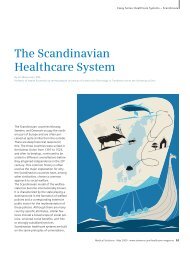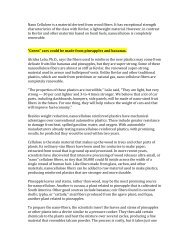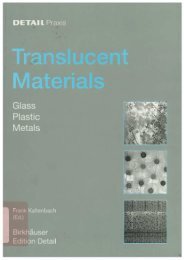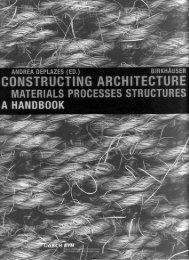Download text-only Bibliography - California College of the Arts
Download text-only Bibliography - California College of the Arts
Download text-only Bibliography - California College of the Arts
Create successful ePaper yourself
Turn your PDF publications into a flip-book with our unique Google optimized e-Paper software.
Lara Manzanares<br />
<strong>the</strong> transition away from life. The storytelling style in this and o<strong>the</strong>r ghost stories<br />
warn us away from this frightening in-between space. This story may have<br />
historical ties to <strong>the</strong> story <strong>of</strong> La Malinche – <strong>the</strong> indigenous companion <strong>of</strong> Hernán<br />
Cortés. She is seen as both a traitor and <strong>the</strong> mo<strong>the</strong>r <strong>of</strong> <strong>the</strong> mestizo race, both<br />
revered and despised. La Llorona is also a song, a haunting musical piece that is<br />
tender, vengeful, wistful and exuberant, all at <strong>the</strong> same time.<br />
Derrida, Jacques. The Truth in Painting. Chicago: University <strong>of</strong> Chicago Press, 1987.<br />
“It is finality-without-end which is said to be beautiful (…). So it is <strong>the</strong> without that<br />
counts for beauty; nei<strong>the</strong>r <strong>the</strong> finality nor <strong>the</strong> end, nei<strong>the</strong>r <strong>the</strong> lacking goal nor <strong>the</strong><br />
lack <strong>of</strong> a goal but <strong>the</strong> edging in sans <strong>of</strong> <strong>the</strong> pure cut, <strong>the</strong> sans <strong>of</strong> <strong>the</strong> finality-sansend”<br />
(89).<br />
“From this point <strong>of</strong> view beauty is never seen, nei<strong>the</strong>r in <strong>the</strong> totality nor outside it:<br />
<strong>the</strong> sans is not visible, sensible, perceptible, it does not exist. And yet <strong>the</strong>re is some <strong>of</strong><br />
it and it is beautiful. It gives <strong>the</strong> beautiful” (90).<br />
“A piece <strong>of</strong> waste land has no fixed limit. Without edge, without any border<br />
marking property, without any nondecomposable frame that would not bear<br />
partition. Vague is a movement without its goal, not a movement without goal but<br />
without its goal. Vague beauty, <strong>the</strong> <strong>only</strong> kind that gives rise to an attribution <strong>of</strong><br />
pure beauty, is an indefinite errance, without limit, stretching toward its orient but<br />
cutting itself <strong>of</strong>f from it ra<strong>the</strong>r than depriving itself <strong>of</strong> it, absolutely. It does not<br />
arrive itself at its destination” (92-93).<br />
“Parerga have a thickness, a surface which separates <strong>the</strong>m not <strong>only</strong> (as Kant would<br />
have it) from <strong>the</strong> integral inside, from <strong>the</strong> body proper <strong>of</strong> <strong>the</strong> ergon, but also from<br />
<strong>the</strong> outside, from <strong>the</strong> wall on which <strong>the</strong> painting is hung…” (61).<br />
*Doe, John & Jane. The Doorway. San Francisco: Lara’s U.S. Census Employment,<br />
2010.<br />
Throughout <strong>the</strong> past summer, I worked as an enumerator for <strong>the</strong> 2010 Census. I<br />
spent 20-30 hours a week seeking out and standing in doorways. Occasionally I<br />
was invited inside, o<strong>the</strong>r times I was threatened and verbally abused. As Census<br />
Employees, we were not allowed to set foot through a doorway unless invited in. At<br />
times, however, even my proximity to <strong>the</strong> doorway was enough to cause a resident<br />
to come unhinged. I thought it very interesting that such a seemingly forgotten or<br />
dismissed space, a space without history, a space that people are in every day but<br />
never spend time in - could trigger such strong emotions.<br />
Hayes, Joe (retold by). “El Terrible Tragadabas,” from Tell Me A Cuento / Cuéntame<br />
Un Story. El Paso: Cinco Puntos, 1998.<br />
“El Terrible Tragadabas” is a children’s story with roots in Spain. It tells <strong>of</strong> a monster<br />
(<strong>the</strong> Tragadabas, or glutton) who hides behind <strong>the</strong> door <strong>of</strong> a small town’s general<br />
store. The three main characters take individual trips to <strong>the</strong> general store, knock on<br />
<strong>the</strong> door and have a brief verbal exchange with <strong>the</strong> monster, who warns <strong>the</strong>m not<br />
to open <strong>the</strong> door. They do anyway, and <strong>the</strong> monster jumps out and tries to<br />
swallow <strong>the</strong>m.<br />
3











